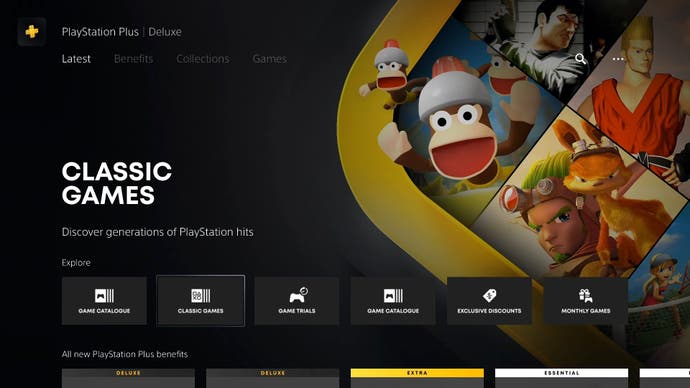Sony's new PlayStation Plus classic games emulators simply aren't good enough
The first PS1, PSP and PS2 titles tested on PS5.
This week, Sony has started rolling out the new PlayStation Plus service with its various tiers including classic games such as PlayStation 1, 2 and PSP titles. Thus far, however, the service is only available in Asian territories. Thankfully, with help from backers of the DF Supporter Program, we have access and have spent time with Sony's official emulation for the original PlayStation, PlayStation 2 and PSP. Consider this a preview of sorts as it may not reflect the experience of UK/EU/US gamers, but it is our first insight into the nuts and bolts of the emulation - and there are clearly major issues the platform holder has to address.
To recap, the new PlayStation Plus consists of three tiers. Essential is pretty much the Plus experience as it stands now, while Extra gives you access to a large library of PS4 and PS5 titles to download and play. It's the top-end Premium tier that offers up the classic games, however, alongside cloud streaming (in supported territories) along with time-limited trials.
So, how does the top tier offering work with regards to classic games? Well, once you sign up, a new menu option becomes available with various categories including the classic games. Click on this and you'll see that - for Asian subscribers at least - just a small handful of titles are currenly available including Tekken 2, Mr Driller, Ape Escape and more. There's also a handful of Jak titles available for PS2 and a single PSP game, the handheld port of Echochrome.
The good news is that the PS1 emulator is not the same code as used in the misbegotten PlayStation Classic, but it's fair to say that it has a whole host of its own issues. When you go to download a game, you're given a choice between the PS5 and PS4 versions - presumably different packages. In some cases, the files size is vastly different between the two. There aren't many games availably initially in this Asian offering and some of the choices are strange, like the inclusion of two Worms games? Still, titles like Ape Escape, Wild Arms, Mr Driller, Tekken 2 and Oddworld are worth a look. On the plus side, the emulator does have new features and options including higher resolution rendering, various display modes and rewind. The question is, how well are those features implemented and how good is the emulation - and are the reports of the disastrous use of 50Hz PAL versions true?
The answer is yes... and no. Some titles are NTSC and generally work fine. But others - including the majority of the Sony first-party games - are indeed 50Hz code. When you boot up Ape Escape, for example, you'll notice mention of Sony Computer Entertainment Europe - yep, it is indeed the PAL version, further confirmed by the ugly title screen logo. However, watching the real-time introduction, it did seem to run at 30fps, not the 25fps I'd expect from a PAL game. However, this 30fps is a stutter-fest and looks truly awful - we're looking at incorrect frame pacing amplified to the max and it looks pretty bad. Once you get in game though, it settles back down to 25 frames per second - as you'd expect from the PAL version.
So what's going on here? My guess is that the cutscenes have special timing related to the pre-recorded audio that is perhaps causing this issue - either something was adjusted for this release or it's a side effect of running within a 60Hz container. But this really gets to the heart of the problem here and the reason why PAL releases are a bad choice. Basically, the PS5 can only output a minimum of 60Hz but PAL versions are made for 50Hz displays. Since 50 frames per second does not divide evenly into the 60Hz refresh rate, there's no other option but to vary the length of time a frame is displayed resulting in inconsistency and stutter.

This emulation fails at first hurdle. Even if the PS5 could swap into a 50Hz mode, the point is that PAL game versions during this era were always compromised. Ape Escape runs around 17 percent slower than the Japanese and US original NTSC versions. The PS5 emulation of Ape Escape not only plays in slow motion - it looks choppy while doing so. This is the problem. I'll stress once again that we are looking at the Asian PSN storefront here, and I really hope that at the very least, the NTSC markets get 60Hz versions - but as a starting point, the use of PAL code is a basic failure.
Looking at the Asian line-up, Wild Arms, Jumping Flash, Kurushi, the two Worms titles and Everybody's Golf are all presented using the PAL version of the game - and in all cases, this means slower gameplay and juddery movement. I think it's clear that the reason Sony selected the PAL versions in this case is language support - European releases tend to offer localisations for five different languages, basically, which is appealing if you weren't fully aware of the issues associated with using a PAL release on a 60Hz machine.
The solution, I feel, can already be found in Nintendo's Online service on Switch - they once dealt with the PAL issue too but now, players can download different versions of the app for each region but still use just one account to play each one. This allows full access to regional variants. This is something Sony should consider - allow access to regional variants. This would effectively eliminate the PAL issue entirely, while still offering access to the multi-language versions as a 'last resort' for those that absolutely must have the localised version.
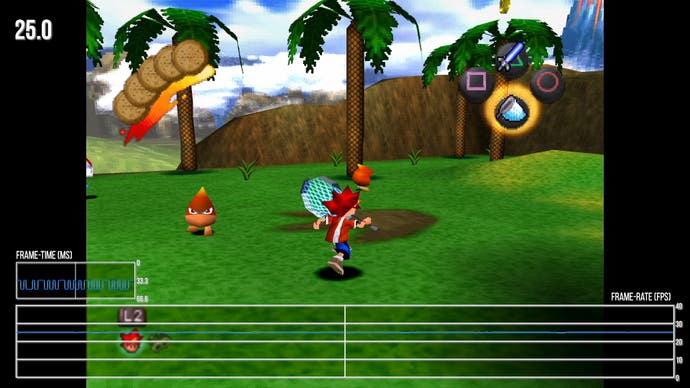
It should be noted, however, that some games do seem to include the preferred NTSC variants - Namco's releases, Tekken 2 and Mr Driller, are both presented at full 60Hz and both are worth a look. And while the majority of Sony first-party titles are PAL, it's curious to note that Syphon Filter is indeed NTSC code.
Moving on, Sony promised enhanced resolution for classic titles and that's exactly what you get. On PlayStation 5, polygon graphics are drawn at a much higher resolution - pixel-counting is tough owing to interpolation but it seems to be in the region of 1920x1440, while 2D elements receive a crisp nearest neighbour upscale - which is a positive thing up against interpolated alternatives (for the record, I also tested the emulation on PS4 Pro, which looks to offer the same resolution and overall effect).
Whether you think the games benefit from this higher resolution is a matter of personal preference. Personally, I'm not a fan of high-resolution rendering for PS1 content, for two reasons. Firstly, there's the lack of floating point precision. Without sub-pixel accuracy, polygon models essentially pop between pixels leading to an unstable, wobbly look. Improving resolution doesn't help here, in fact, it makes the effect more visible. Secondly, I don't much care for the mismatch between low resolution assets such as UI elements and high-resolution polygon rendering.
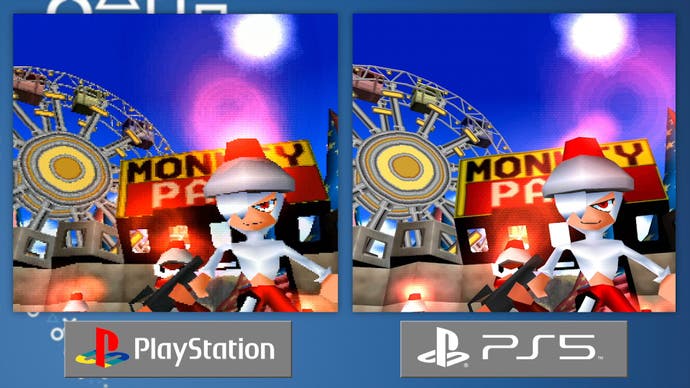
There's another potential banana skin too - whether the emulator can cope with PS1's low resolution 240p mode and the 480i higher resolution interlaced mode. Mr Driller and Intelligent Qube both use the 480i mode and it's here where the emulator works well: the image is clean and presented at full resolution without any interlacing artefacts. The emulator transitions between high-res and low-res scenes without issue as well. So, this is one area where Sony has delivered exactly what I would have hoped.
There are also additional visual rendering modes too, which fall under two categories: filters and pixel/aspect ratio options. Filter wise, we have three options: default, retro classic and modern. Default and modern both look nearly identical - the difference is that modern seems to boost contrast leading to a darker image. Retro classic, however, introduces a scanline filter. It looks OK at a glance - it softens the image, slightly boosts contrast and adds a scanline overlay to the mix. The problem is, it doesn't align perfectly with the pixel grid, meaning that it doesn't look as good as it should. Compared to the scanline generator in the RetroTink 5x Pro upscaler, it's clear that Sony's emulator falls short.
The aspect ratio options are also strange. By default, the emulator opts for the 4:3 within a 16:9 window and this seems to work as advertised, but the 1:1 and square pixels options have got issues. I'm not sure what these options actually correspond to but it does not match the PlayStation's pixel grid at all. Both options render narrow pixels, basically, resulting in a squished image, with incorrect scaling. I tested this with the PAL games which have a slightly different resolution, but these same issues exist with the NTSC releases too. I suspect this is a result of trying to fill the screen but that's what these options should be used to correct - they simply don't work.
So basically, none of the scaling or display options are well implemented nor do they perform as the names would imply. It feels like they were designed by someone that didn't understand what such options are designed to achieve in other emulator and hardware solutions.

That's the state of PS1 emulation on PS5 then - there are some good things here but also plenty of missteps. This is the first time Sony has opted for enhancing PS1 games but these improvements just don't work out well. What's particularly disappointing is that the retro community has handed in superior solutions to the problem. As I mentioned earlier, the RetroTink 5x Pro - the work of one man - delivers far superior scaling and scanline options. Meanwhile. The PGXP feature on DuckStation solves the wobbly polygons and affine texture warping issues that the Sony emulator does not.
Another sobering though concerns Sony's prior emulation work. The PS1 compatibility feature on PlayStation 3 was known for boosting performance on titles with unstable frame-rates. Perhaps it was unintentional but it was a welcome feature. No such option is available on PS5 so don't expect any improvements in that regard.
Moving on to the PSP emulator, there's just one game to test in the Asian selection: Echochrome. As a handheld, PSP never had 50Hz PAL versions so we don't need to worry about that, and it's nice to see the system's native 480x272 resolution receiving a boost to 1080p. However, 2D elements are simply upscaled and filtered, resulting in blurry artwork. This won't be a huge issue in every case, but it does mean that potentially, any 2D games released on this service will have a similarly blurry look.
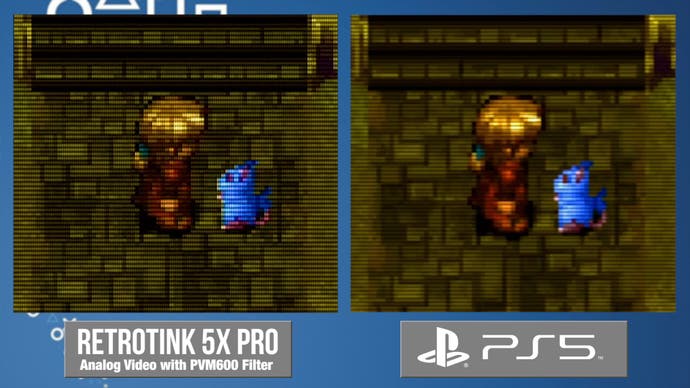
Secondly, the scaling and display options are very weird too. The retro classic mode, for instance, simply enables the same scanline filter as PS1. The PSP uses an LCD panel - there is no reason to simulate scanlines for these games. There should be a dot-matrix filter at the very least but that's not there. The other display options are also largely illogical - the 1:1 pixel and square pixel modes, for instance, once again present a super narrow image. This doesn't make sense: the PSP's native pixel resolution is actually 16:9 so square pixels should retain this aspect ratio, which doesn't happen here. There's no reason to squish the image for PSP games at all, in fact.
Lastly, I want to briefly touch on PS2 emulation - essentially, we're seeing the same PS2 Classics setup as on PS4. There is no native PS5 application for these games. The thing is - many of these PS2 Classics did not run correctly on PS5 but based on the Asian titles available for testing, they do seem to have the same image quality as PS2 Classics on PS4, namely a two-by-two resolution increase over the original release. However, the emulation itself traditionally had issues and none of them appear to have been addressed. Take Jak and Daxter, for example. The PS2 Classic on PS4 had performance problems that the original game never had - and once again, those same frame-rate problems rear up on PlayStation 5 too.
What this also means is that there's a lack of consistency between the PS1/PSP emulators and the PS2 equivalent: features like rewind, save state and the scaling options are not available on the PS2 Classics emulator. I'm also going to be curious to see how other PS2 Classics titles play out on PS5, because some of the existing releases don't run correctly via back-compat. Hopefully they will be updated to work properly with the new hardware, as opposed to not releasing them for PS5 owners.
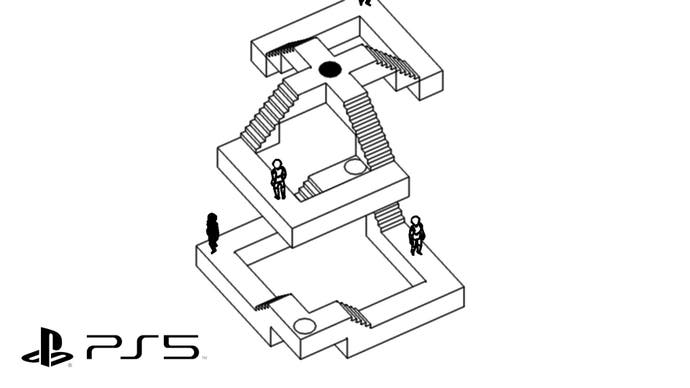
In summary, the state of classic games via PlayStation Plus is not in a great place - but it's not an unsalvageable situation. Nintendo had the same issues with 50Hz PAL versions and solved the problem simply by allowing users to select the game territory of their choice, so, for a UK gamer looking for the 'proper' 60Hz experience, the ability to access the US release solves the problem at a stroke. This is a simple, streamlined solution that Sony should mirror.
Elsewhere, issues with the scaler, filters and higher resolution rendering can all be addressed by Sony taking a good look at the standards set by retro enthusiast hardware and software with the aim being to match or better it. Getting the PS2 Classics emulator into shape will be more challenging, however, and hopes aren't high there bearing in mind that this code debuted on PS4 way back in 2015 and looks much the same seven years later. Regardless, it needs to be addressed.
I only hope the team responsible for these releases considers some of the issues highlighted by myself and others and sets out to improve the results. Bearing in mind the cost premium added to PlayStation Plus for access to these classic titles, it's disappointing to see that the retro enthusiast community is so far ahead of Sony's own efforts. In the meantime, I'll keep on playing these games on original hardware - but I hope other users have a chance to properly enjoy these games in the future on modern Sony consoles.
